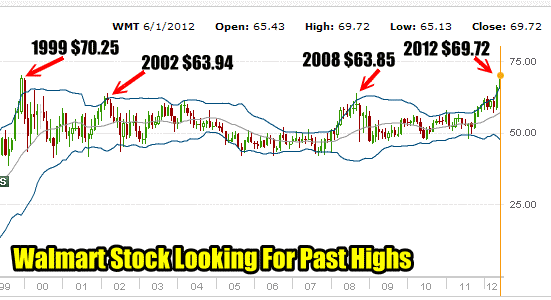
Walmart stock has been a great stock investment for a lot of people. I received quite a number of emails from readers wondering if they should be selling their Walmart Stock. They all ask the same thing about their stock investment. “Is It Time To Sell Walmart Stock”. I cannot tell you yes or no because a lot depends on what your outlook is and what your needs are, including tax implications for those holding Walmart stock outside a stock investment portfolio in a retirement account. But I can tell you the stock technical analysis you can do to determine if Walmart Stock is about to end its run.
Knowing When To Sell A Stock Investment
When a stock that has been purchased, such as Walmart Stock, begins to rise many investors wonder where they should sell. This is definitely one area that financial planners, analysts, investors friends and even smart money traders have terrible track records for. Everyone can tell you what to buy but never when to sell.
Knowing when to sell a stock investment is actually easier than you think. One of the most common ways to sell a rising stock is with a STOP-LOSS. Let’s see how a stop-loss could be used on Walmart Stock.
OnLine Stop-Loss Calculators
There are many on-line stop-loss calculators and some investors definitely use them. Overall though these stop-loss calculators cannot judge the exact stock you are invested in. They basically look at highs, lows, previous percentage moves, volatility indexes and more. But in the end they cannot judge what you see in front of you on the technical chart, which is a stock like Walmart Stock continuing to climb every day. You know that one day Walmart Stock will pullback and the rise will be over, but no online calculator can give you the pricve point to get out.
You can however do this yourself if you are following a specific stock, such as Walmart Stock and are aware of its closing prices.
Using A Stop Loss On Walmart Stock
There are many thoughts on the best way to use a stop-loss. Some investors set up a stop-loss for the amount of return they are willing to lose in the event Walmart stock pulls back. Let’s say I am willing to risk a 2.5% pull back in Walmart stock.
I therefore look at each day’s closing Walmart Stock price and put in my 2.5% stop-loss based on the highest price to that date. If Walmart stock moves higher I calculate 2.5% from the higher price. If the stock pulls back the stop-loss is not changed. Let me show you what I mean.
Stock Investment WALMART STOCK CLOSING PRICE
June 7 – $65.87
If this was my first day for buying Walmart stock I would put in my stop-loss at 2.5% or $64.22. If the stock fell to $64.22 I would be sold out. Remember when using a stop-loss, there is no guarantee that your stop-loss price will be the price you get for your stock investment. If the stock should plummet you will be filled at whatever price the market maker got as the stock fell to or below your $64.22. If, for example your stock investment in Walmart Stock suddenly plunged on some bad news and opened at $63.50, you will be sold out at $63.50. This is something to keep in mind when using stop losses.
For myself I prefer to use what is known as a soft stop-loss. This is a stop-loss that you have not entered but written down and are ready to sell at if you see the stock starting to fall. For example June 7 was a Thursday. If on Friday the stock fell to $64.50, I would then put in my order to sell at $64.22. I only put in my stop-loss when the stock is pulling back, not plunging. By using a soft stop-loss I won’t get whipsawed out as easily should some bad news push down my stock investment temporarily.
June 8 – $68.22
On June 8 Walmart stock rose to $68.22. This is higher than $65.87 so I moved my stop-loss to $66.52 which is 2.5% of $68.22.
Over the course of June 11 to June 19, Walmart stock never fell to $66.52 but instead stayed between $67.07 and $68.12. Because there were no higher highs, my stop-loss did not change but remained at $66.52.
June 20 – $68.52
On June 20 Walmart Stock rose higher than June 8. My stop-loss was moved up again. This time the Walmart stock stop-loss was set at $66.81.
On June 21, June 22 and June 25 Walmart Stock did not move higher but also not below $66.81.
On June 26 Walmart Stock moved to $68.58, six cents higher. In a case like this I rarely move my stop-loss.
The same on June 27 when Walmart Stock moved to $68.59.
But on June 29 the stock moved to $69.72 which is higher than any previous highs. My stop-loss on my stock investment in Walmart Stock would change to $68.01.
You can see from the above examples how the stop-loss works. Again I caution investors that I believe using a soft stop-loss is superior.
How To Decide On The Percentage For A Stop Loss
Stocks fall into a range of volatility and price swings. For example, Johnson and Johnson stock has a narrow trading range most of the time. Exxon Stock has a wider trading range. So how can an investor decide what percentage to use?
You could simply decide what you are willing to lose on the stock’s rise. A lot of investors do just that. For our Walmart stock example they may be willing to risk the loss of $1.25. They therefore adjust the stop-loss to reflect that amount rather than my 2.5%.
For myself I usually take these steps. I look back at the history of the stock to try to see what percentages range Walmart Stock has been in. For Walmart Stock for example I look back two or three months and look at the weekly range for Walmart Stock.
For example let’s go back to the Week of May 29 to June 1, a short trading week. These are the closing Walmart Stock Prices.
May 29 – $65.68
May 30 – $65.44
May 31 – $65.82
June 1 – $65.55
Looking at the movement in Walmart Stock the lowest close for the week was $65.44 and the highest $65.82. This is a movement of 0.58% or .38 cents
Let’s compare the next week for closing Walmart Stock Prices.
June 4 – $65.99
June 5 – $65.50
June 6 – $65.93
June 7 – $65.87
June 8 – $68.22
The low was $65.50 and the high $68.22. This is a difference of $2.72 or 4%.
We now need to see if 4% is an unusual move.
Let’s pick another week for the closing Walmart Stock Prices.
June 11 – $67.53
June 12 – $67.72
June 13 – $67.07
June 14 – $67.63
June 15 – $67.75
The low for this week was $67.07 and the high $67.75 for Walmart Stock. This is a difference of .68 cents or 1%.
Let’s review another week.
May 7 – $59.19
May 8 – $59.05
May 9 – $59.03
May 10 – $59.19
May 11 – $59.42
The low for this week was $59.03 and the high $59.42. The difference is .39 cents or about 0.6%.
After reviewing 4 weeks of Walmart Stock closing prices, we find four different readings, 0.5%; 0.6%; 1% and 4%.
What Does The Weekly History Of Walmart Stock Tell Investors?
As far as a stock investment is concerned Walmart has fairly limited volatility. This means 2.5% is probably too much to allow for a stop-loss. Based on the weekly Walmart Stock movement percentage readings taken over the above weeks a tighter stop-loss is definitely in order. Since the readings were 0.5%, 0.6% 1.0% and 4%, I would remove the 4% because a 4% drop is something I would not want to have happen in my stock investment.
1% seems fairly normal for a stock like Walmart and if you add a few more weeks you will see that 1% happens reasonably often. But I am willing to give up 1% in a move as 1% within Walmart stock at my purchase price of $65.87 on June 7 is only .65 cents. 1.5% is about $1.00. I think I would be willing to give up $1.00. 2% would be $1.30. That would be all I am willing to give up particularly based on the history of Walmart Stock. I therefore would adjust my stop-loss on Walmart Stock to 2%.
To review then, my stop-loss would change to:
June 7 – $65.87 less 2% = $64.56
June 8 – $68.22 less 2% = $66.86
June 20 – $68.52 less 2% = $67.15
June 29 – $69.72 less 2% = $68.33
Looking at the month of June at no time was my stop-loss reached and I have gone from $64.56 to $68.15 for a total gain of 5.5% and not been stopped out. My stop-loss choice of 2% was a good choice.
Changing The Stop Loss Rules As Walmart Stock Climbs
When a stock investment climbs investors become nervous. They don’t want to sell too early but at the same time they don’t want to sell too late. Some investors will tighten the percentage used for the stop-loss as the stock climbs. For example by the time the stock is at $69.72 on June 29, some investors may change to 1.25% placing their stop-loss at $68.67.

Reviewing the past history of a stock investment like Walmart Stock can give clues as to when a stock may be entering overvaluation.
Other investors look back to see where the highest Walmart Stock price was over perhaps a 5 to 10 year period. Walmart Stock price was as high as $70.25 in December 1999. Other highs include $63.94 in March 2002 and $63.85 in September 2008. What this tells investors is that Walmart Stock Price at present is reaching all time highs. For some investors they would tighten their stop-loss as the stock climbs above past highs.
Other factors need to be taken into account including the reasons for the rise in Walmart Stock. Are earnings going to support a continued rise in the stock. Comparing earnings over the years versus the numbered of issued shares each year will assist in determining whether or not the rise in Walmart Stock is justified and the stock is actually not overvalued. If that was the case then many investors will not tighten their percentage as the stock rises.
There Are No Set Rules For Stop Loss
There are no set rules for the use of a stop-loss. In upcoming articles I will look at other methods for the stop-loss including the stock technical analysis tools that I add to the stop-loss to assist me in timing when to sell out of a rising stock investment such as Walmart Stock.
